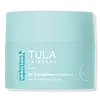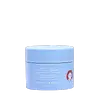What's inside
What's inside
 Key Ingredients
Key Ingredients

 Benefits
Benefits

 Concerns
Concerns

No concerns
 Ingredients Side-by-side
Ingredients Side-by-side

Water
Skin ConditioningGlycerin
HumectantC13-15 Alkane
SolventPropanediol
SolventSodium Acrylates Copolymer
Maris Aqua
HumectantCollagen Amino Acids
MoisturisingCitrullus Lanatus Fruit Extract
Skin ConditioningPyrus Malus Fruit Extract
Skin ConditioningHydrolyzed Rice Protein
Skin ConditioningPunica Granatum Pericarp Extract
Skin ConditioningNiacinamide
SmoothingLactococcus Ferment Lysate
Skin ConditioningLactobacillus
Skin ConditioningLactobacillus Ferment
Skin ConditioningCurcuma Longa Root Extract
MaskingLactic Acid
BufferingAlpha-Glucan Oligosaccharide
CleansingBeta Vulgaris Root Extract
Skin ConditioningSodium Hyaluronate
HumectantLens Esculenta Fruit Extract
Skin ConditioningPolymnia Sonchifolia Root Juice
Skin ConditioningSodium Acetylated Hyaluronate
HumectantHydrolyzed Sodium Hyaluronate
Skin ConditioningSodium Hyaluronate Crosspolymer
HumectantTetrahexyldecyl Ascorbate
AntioxidantInulin
Skin ConditioningLeuconostoc/Radish Root Ferment Filtrate
AntimicrobialVaccinium Myrtillus Leaf Extract
AstringentPterocarpus Marsupium Bark/Wood Extract
Sodium PCA
HumectantCoco-Caprylate/Caprate
EmollientLecithin
Emollient1,2-Hexanediol
Skin ConditioningUrea
BufferingLysolecithin
EmulsifyingPentylene Glycol
Skin ConditioningHydroxyacetophenone
AntioxidantCaprylhydroxamic Acid
Trisodium Ethylenediamine Disuccinate
Sodium Lactate
BufferingCitric Acid
BufferingPhenethyl Alcohol
MaskingTocopheryl Acetate
AntioxidantCaprylyl Glycol
EmollientMaltodextrin
AbsorbentSodium Benzoate
MaskingPotassium Sorbate
PreservativePhytic Acid
Sodium Hydroxide
BufferingButylene Glycol
HumectantTocopherol
AntioxidantSodium Chloride
MaskingEthylhexylglycerin
Skin ConditioningCI 42090
Cosmetic ColorantWater, Glycerin, C13-15 Alkane, Propanediol, Sodium Acrylates Copolymer, Maris Aqua, Collagen Amino Acids, Citrullus Lanatus Fruit Extract, Pyrus Malus Fruit Extract, Hydrolyzed Rice Protein, Punica Granatum Pericarp Extract, Niacinamide, Lactococcus Ferment Lysate, Lactobacillus, Lactobacillus Ferment, Curcuma Longa Root Extract, Lactic Acid, Alpha-Glucan Oligosaccharide, Beta Vulgaris Root Extract, Sodium Hyaluronate, Lens Esculenta Fruit Extract, Polymnia Sonchifolia Root Juice, Sodium Acetylated Hyaluronate, Hydrolyzed Sodium Hyaluronate, Sodium Hyaluronate Crosspolymer, Tetrahexyldecyl Ascorbate, Inulin, Leuconostoc/Radish Root Ferment Filtrate, Vaccinium Myrtillus Leaf Extract, Pterocarpus Marsupium Bark/Wood Extract, Sodium PCA, Coco-Caprylate/Caprate, Lecithin, 1,2-Hexanediol, Urea, Lysolecithin, Pentylene Glycol, Hydroxyacetophenone, Caprylhydroxamic Acid, Trisodium Ethylenediamine Disuccinate, Sodium Lactate, Citric Acid, Phenethyl Alcohol, Tocopheryl Acetate, Caprylyl Glycol, Maltodextrin, Sodium Benzoate, Potassium Sorbate, Phytic Acid, Sodium Hydroxide, Butylene Glycol, Tocopherol, Sodium Chloride, Ethylhexylglycerin, CI 42090
Water
Skin ConditioningGlycerin
HumectantSqualane
EmollientDimethicone
EmollientPhenyl Trimethicone
Skin ConditioningBetaine
HumectantNiacinamide
SmoothingPentylene Glycol
Skin ConditioningPolyglyceryl-3 Polydimethylsiloxyethyl Dimethicone
Skin ConditioningPropanediol
SolventSodium Hyaluronate
HumectantCeramide NP
Skin ConditioningColloidal Oatmeal
AbsorbentTocopherol
AntioxidantSorbitan Isostearate
EmulsifyingDecyl Glucoside
CleansingSodium Acryloyldimethyltaurate/Vp Crosspolymer
Emulsion StabilisingHydroxyethyl Acrylate/Sodium Acryloyldimethyl Taurate Copolymer
Emulsion StabilisingCaprylyl Glycol
EmollientEthylhexylglycerin
Skin ConditioningButylene Glycol
HumectantDimethicone/Polyglycerin-3 Crosspolymer
CleansingGlyceryl Glucoside
HumectantDimethiconol
EmollientPolysilicone-11
1,2-Hexanediol
Skin ConditioningHydroxyacetophenone
AntioxidantHexylene Glycol
EmulsifyingPhenoxyethanol
PreservativePolysorbate 60
EmulsifyingWater, Glycerin, Squalane, Dimethicone, Phenyl Trimethicone, Betaine, Niacinamide, Pentylene Glycol, Polyglyceryl-3 Polydimethylsiloxyethyl Dimethicone, Propanediol, Sodium Hyaluronate, Ceramide NP, Colloidal Oatmeal, Tocopherol, Sorbitan Isostearate, Decyl Glucoside, Sodium Acryloyldimethyltaurate/Vp Crosspolymer, Hydroxyethyl Acrylate/Sodium Acryloyldimethyl Taurate Copolymer, Caprylyl Glycol, Ethylhexylglycerin, Butylene Glycol, Dimethicone/Polyglycerin-3 Crosspolymer, Glyceryl Glucoside, Dimethiconol, Polysilicone-11, 1,2-Hexanediol, Hydroxyacetophenone, Hexylene Glycol, Phenoxyethanol, Polysorbate 60
 Reviews
Reviews

Ingredients Explained
These ingredients are found in both products.
Ingredients higher up in an ingredient list are typically present in a larger amount.
1,2-Hexanediol is a synthetic liquid and another multi-functional powerhouse.
It is a:
- Humectant, drawing moisture into the skin
- Emollient, helping to soften skin
- Solvent, dispersing and stabilizing formulas
- Preservative booster, enhancing the antimicrobial activity of other preservatives
Butylene Glycol (or BG) is used within cosmetic products for a few different reasons:
Overall, Butylene Glycol is a safe and well-rounded ingredient that works well with other ingredients.
Though this ingredient works well with most skin types, some people with sensitive skin may experience a reaction such as allergic rashes, closed comedones, or itchiness.
Learn more about Butylene GlycolCaprylyl Glycol is a humectant and emollient, meaning it attracts and preserves moisture.
It is a common ingredient in many products, especially those designed to hydrate skin. The primary benefits are retaining moisture, skin softening, and promoting a healthy skin barrier.
Though Caprylyl Glycol is an alcohol derived from fatty acids, it is not the kind that can dry out skin.
This ingredient is also used as a preservative to extend the life of products. It has slight antimicrobial properties.
Learn more about Caprylyl GlycolEthylhexylglycerin (we can't pronounce this either) is commonly used as a preservative and skin softener. It is derived from glyceryl.
You might see Ethylhexylglycerin often paired with other preservatives such as phenoxyethanol. Ethylhexylglycerin has been found to increase the effectiveness of these other preservatives.
Glycerin is already naturally found in your skin. It helps moisturize and protect your skin.
A study from 2016 found glycerin to be more effective as a humectant than AHAs and hyaluronic acid.
As a humectant, it helps the skin stay hydrated by pulling moisture to your skin. The low molecular weight of glycerin allows it to pull moisture into the deeper layers of your skin.
Hydrated skin improves your skin barrier; Your skin barrier helps protect against irritants and bacteria.
Glycerin has also been found to have antimicrobial and antiviral properties. Due to these properties, glycerin is often used in wound and burn treatments.
In cosmetics, glycerin is usually derived from plants such as soybean or palm. However, it can also be sourced from animals, such as tallow or animal fat.
This ingredient is organic, colorless, odorless, and non-toxic.
Glycerin is the name for this ingredient in American English. British English uses Glycerol/Glycerine.
Learn more about GlycerinHydroxyacetophenone is antioxidant with skin conditioning and soothing properties. It also boosts the efficiency of preservatives.
This ingredient is not irritating or sensitizing.
Niacinamide is a multitasking form of vitamin B3 that strengthens the skin barrier, reduces pores and dark spots, regulates oil, and improves signs of aging.
And the best part? It's gentle and well-tolerated by most skin types, including sensitive and reactive skin.
You might have heard of "niacin flush", or the reddening of skin that causes itchiness. Niacinamide has not been found to cause this.
In very rare cases, some individuals may not be able to tolerate niacinamide at all or experience an allergic reaction to it.
If you are experiencing flaking, irritation, and dryness with this ingredient, be sure to double check all your products as this ingredient can be found in all categories of skincare.
When incorporating niacinamide into your routine, look out for concentration amounts. Typically, 5% niacinamide provides benefits such as fading dark spots. However, if you have sensitive skin, it is better to begin with a smaller concentration.
When you apply niacinamide to your skin, your body converts it into nicotinamide adenine dinucleotide (NAD). NAD is an essential coenzyme that is already found in your cells as "fuel" and powers countless biological processes.
In your skin, NAD helps repair cell damage, produce new healthy cells, support collagen production, strengthen the skin barrier, and fight environmental stressors (like UV and pollution).
Our natural NAD levels start to decline with age, leading to slower skin repair, visible aging, and a weaker skin barrier. By providing your skin niacinamide, you're recharging your skin's NAD levels. This leads to stronger, healthier, and younger looking skin.
Another name for vitamin B3 is nicotinamide. This vitamin is water-soluble and our bodies don't store it. We obtain Vitamin B3 from either food or skincare. Meat, fish, wheat, yeast, and leafy greens contain vitamin B3.
The type of niacinamide used in skincare is synthetically created.
Learn more about NiacinamidePentylene glycol is typically used within a product to thicken it. It also adds a smooth, soft, and moisturizing feel to the product. It is naturally found in plants such as sugar beets.
The hydrophilic trait of Pentylene Glycol makes it a humectant. As a humectant, Pentylene Glycol helps draw moisture from the air to your skin. This can help keep your skin hydrated.
This property also makes Pentylene Glycol a great texture enhancer. It can also help thicken or stabilize a product.
Pentylene Glycol also acts as a mild preservative and helps to keep a product microbe-free.
Some people may experience mild eye and skin irritation from Pentylene Glycol. We always recommend speaking with a professional about using this ingredient in your routine.
Pentylene Glycol has a low molecular weight and is part of the 1,2-glycol family.
Learn more about Pentylene GlycolPropanediol is an all-star ingredient. It softens, hydrates, and smooths the skin.
It’s often used to:
Propanediol is not likely to cause sensitivity and considered safe to use. It is derived from corn or petroleum with a clear color and no scent.
Learn more about PropanediolSodium Hyaluronate is hyaluronic acid's salt form. It is commonly derived from the sodium salt of hyaluronic acid.
Like hyaluronic acid, it is great at holding water and acts as a humectant. This makes it a great skin hydrating ingredient.
Sodium Hyaluronate is naturally occurring in our bodies and is mostly found in eye fluid and joints.
These are some other common types of Hyaluronic Acid:
Learn more about Sodium HyaluronateTocopherol (also known as Vitamin E) is a common antioxidant used to help protect the skin from free-radicals and strengthen the skin barrier. It's also fat soluble - this means our skin is great at absorbing it.
Vitamin E also helps keep your natural skin lipids healthy. Your lipid skin barrier naturally consists of lipids, ceramides, and fatty acids. Vitamin E offers extra protection for your skin’s lipid barrier, keeping your skin healthy and nourished.
Another benefit is a bit of UV protection. Vitamin E helps reduce the damage caused by UVB rays. (It should not replace your sunscreen). Combining it with Vitamin C can decrease sunburned cells and hyperpigmentation after UV exposure.
You might have noticed Vitamin E + C often paired together. This is because it is great at stabilizing Vitamin C. Using the two together helps increase the effectiveness of both ingredients.
There are often claims that Vitamin E can reduce/prevent scarring, but these claims haven't been confirmed by scientific research.
Learn more about TocopherolWater. It's the most common cosmetic ingredient of all. You'll usually see it at the top of ingredient lists, meaning that it makes up the largest part of the product.
So why is it so popular? Water most often acts as a solvent - this means that it helps dissolve other ingredients into the formulation.
You'll also recognize water as that liquid we all need to stay alive. If you see this, drink a glass of water. Stay hydrated!
Learn more about Water